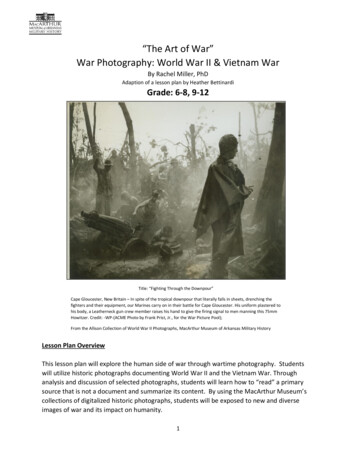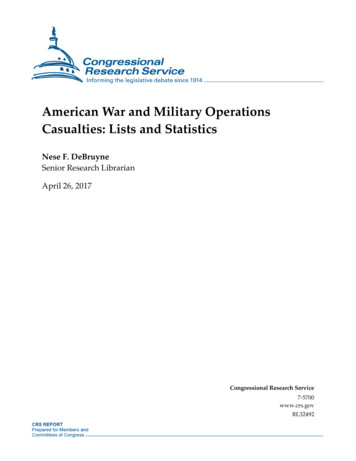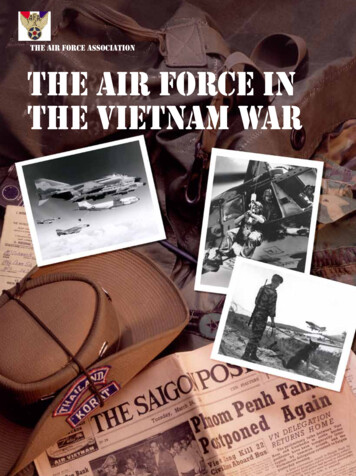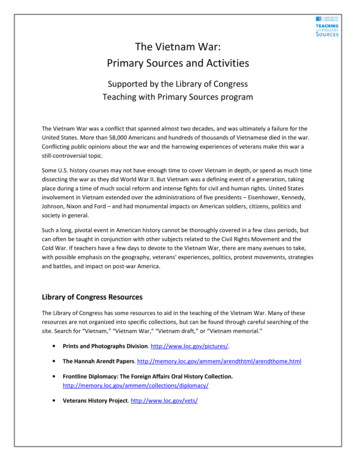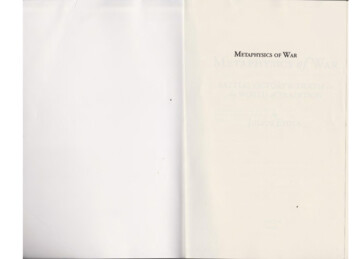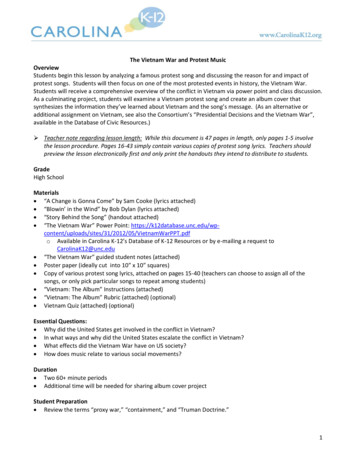
Transcription
The Vietnam War and Protest MusicOverviewStudents begin this lesson by analyzing a famous protest song and discussing the reason for and impact ofprotest songs. Students will then focus on one of the most protested events in history, the Vietnam War.Students will receive a comprehensive overview of the conflict in Vietnam via power point and class discussion.As a culminating project, students will examine a Vietnam protest song and create an album cover thatsynthesizes the information they’ve learned about Vietnam and the song’s message. (As an alternative oradditional assignment on Vietnam, see also the Consortium’s “Presidential Decisions and the Vietnam War”,available in the Database of Civic Resources.)Teacher note regarding lesson length: While this document is 47 pages in length, only pages 1-5 involvethe lesson procedure. Pages 16-43 simply contain various copies of protest song lyrics. Teachers shouldpreview the lesson electronically first and only print the handouts they intend to distribute to students.GradeHigh SchoolMaterials “A Change is Gonna Come” by Sam Cooke (lyrics attached) “Blowin’ in the Wind” by Bob Dylan (lyrics attached) “Story Behind the Song” (handout attached) “The Vietnam War” Power Point: s/31/2012/05/VietnamWarPPT.pdfo Available in Carolina K-12’s Database of K-12 Resources or by e-mailing a request toCarolinaK12@unc.edu “The Vietnam War” guided student notes (attached) Poster paper (ideally cut into 10” x 10” squares) Copy of various protest song lyrics, attached on pages 15-40 (teachers can choose to assign all of thesongs, or only pick particular songs to repeat among students) “Vietnam: The Album” Instructions (attached) “Vietnam: The Album” Rubric (attached) (optional) Vietnam Quiz (attached) (optional)Essential Questions: Why did the United States get involved in the conflict in Vietnam? In what ways and why did the United States escalate the conflict in Vietnam? What effects did the Vietnam War have on US society? How does music relate to various social movements?Duration Two 60 minute periods Additional time will be needed for sharing album cover projectStudent Preparation Review the terms “proxy war,” “containment,” and “Truman Doctrine.”1
o Proxy War –a war that results when two powers use third parties as substitutes for fighting each otherdirectly. Vietnam was a proxy war for the Soviet Union because they supplied N. Vietnam but did notactually participate in the fighting.o Containment – US foreign policy during the Cold War that pledged to contain the spread ofcommunism across the globe using economic, diplomatic, and military means. First outlined in theTruman Doctrine.o Truman Doctrine – President Harry Truman’s pledge to “support free peoples who are resistingattempted subjugation by armed minorities or by outside pressures.” The “outside pressure” he isreferring to indirectly is communism.(Optional) For homework have students complete the “French Indochina Map” (attached) prior tobeginning this lessonProcedureDay OneWarm Up – Protest Music1. As a warm-up, pass out or project the lyrics for one of the following songs (attached). Students shouldexamine the lyrics while you play the song. (Both songs can be downloaded from iTunes for a small chargeor accessed via an internet search. “A Change is Gonna Come” by Sam Cooke. “Blowin in the Wind” by Bob Dylan2. After examining the lyrics and listening to the song, discuss: What do you think this song is about? Provide one example from the lyrics that supports your answer. When do you think this song was written? What evidence do you have that supports your answer? What is this type of song called?o There can be multiple answers for this question, but protest song is the answer that is mostappropriate for this lesson. Why do people protest? What are additional ways of protesting, other than through music? What was Bob Dylan or Sam Cooke protesting? Answers may include:o Treatment of African Americans in the United States before and during the Civil Rights movement.o Protesting in support of the Civil Rights Movement. If you disagree with government policies or actions, such as a law, a war, etc., why is it important tovoice your concern?3. Project and have a student read the “Story Behind the Song” handout (attached). These handouts explainwhat the song is about and the incident(s) that inspired its creation. Explain that music is an importantaspect of many protest movements. Ask students if they can think of any other examples that illustratethis (i.e. the Civil Rights movement; famous songs included “Eyes on the Prize”. “We Shall Overcome”, etc.)Hopefully, a student will also mention the Vietnam War. Tell students that in today’s lesson, they willbegin learning about this complicated period of history, as well as exploring some of the music thatcharacterized the time period. Ask students to share what they already know or think they know aboutthe Vietnam War, noting responses on the board.Overview of Vietnam - Power Point4. Tell students that the situation in Vietnam is complicated and can be quite confusing and that they willthus start by learning some basic facts regarding the conflict. Pass out the attached guided notes sheetsthat accompany the Power Point, which will help students who have difficulty taking notes and will alsostreamline the note taking process in a class with limited time. Instruct students to follow along and posequestions as they have them. While students will be taking notes throughout the PPT, it is importantteachers use this as a conversational piece rather than simply lecture.2
5. Teacher Notes: This power point is intended to be a brief overview of the Vietnam War. It includes manyof the major military and political figures, events, and terminology associated with the Vietnam War.Discussion points and corresponding slides are listed below. It is likely that teachers will want to break thispresentation up over two class periods. The presentation notes a stopping place at slide 21, thoughteachers should use their discretion as to where to stop.) Slide 3 – What other events could have influenced the creation of the Domino Theory?o Spread of communist governments to Eastern Europe after World War II.o China becoming a communist nationo Korean War Slide 13 – Additional information regarding The Gulf of Tonkin Incident:o The Gulf of Tonkin Incident was actually two separate events. On August 2nd 1964 Vietnamesetorpedo boats attacked a group of US destroyers. Two days later it was reported that a group ofUS destroyers was again “deliberately attacked.” This second attack was the impetus for the Gulfof Tokin Resolution and for the escalation of US military presence in Vietnam. A declassified NSAreport from 2005 alleged that the first attack against US ships was under questionablecircumstances and that the second incident never occurred. At the time, it was not entirely certainto Johnson and his staff that the second attacked occurred, yet they still pressed ahead in askingCongress for authorization to escalate the war.o Source: http://www.gwu.edu/ nsarchiv/NSAEBB/NSAEBB132/o Why do you think that President Johnson would use faulty intelligence as a basis for troopescalation in Vietnam? Slide 14 – Why do you think Congress decided to allow a resolution of force rather than officiallydeclaring war on Vietnam?o Possible answers include:If an official war was declared, China and/or Russia might declare war on the US leading toanother potential World War.The resolution allowed for a limited rather than a total war. Johnson himself said that "theUnited States. seeks no wider war".The United States felt that the increased military presence in Vietnam would bring a quick endto the conflict and avert the need for a declaration of war. Slide 16 – What other wars were VC style tactics used in?o Iraq War, War in Afghanistan, American Revolution Slide 19– What does the Killed in Action chart tell you about the enemy the United States was facing inVietnam?o The Vietnamese were ready to die to defend their homeland. This makes them an extremelydifficult opponent to defeat.Design Your Own Vietnam-era Album Cover6. After reaching slide 21, stop the power point and remind students of the initial protest songs they listenedto and discuss: Given what you have learned so far, why do you think artists created songs to protest the Vietnamconflict? Do you think that protest music has any effect on the actions of governments? Does protest musicinspire people to take action? Explain. How do the songs that you listened to at the beginning of class relate to the Vietnam War? What would you call a song that supports the Vietnam War? Can you think of any songs that havebeen written that support various wars?7. Tell students that they are going to be assigned a protest song from the Vietnam War era. They will thencreate an album cover for the song that reflects the lyrics, as well as two events from the power pointpresentation they just viewed and will continue viewing tomorrow. Students should also use theirtextbook for additional events surrounding Vietnam. (For students that are not artistically gifted,3
magazine or printed pictures may be used.) Hand out the attached assignment sheet, as well as a copy ofone of the twenty-seven attached protest songs to each student. (For larger class sizes, assign a song morethan once.) Tell students that while they will begin brainstorming their project for homework, theyshould not make any final decisions on their album cover until after viewing the remainder of the powerpoint the following day in class.Teacher Note - The following protest songs are attached on pages 15-40: “Fortunate Son” by Creedence Clearwater Revival “Fixin’ to Die Rag” by Country Joe McDonald “Draft Dodger Rag” by Phil Ochs “Bring ‘Em Home” by Pete Seeger “War” by Edwin Starr “War Pigs” by Black Sabbath “Give Peace a Chance” by John Lennon “Lyndon Johnson Told the Nation” by Tom Paxton “I Ain’t Marchin’ Anymore” by Phil Ochs “What’s Going On?” by Marvin Gaye “It Better End Soon” by Chicago “Ohio” by Neil Young “Ballad of Penny Evans” by Steve Goodman “Eve of Destruction” by Barry McGuire “Goodnight Saigon” by Billy Joel “Peace Train” by Cats Stevens “Sky Pilots” by the Animals “The Unknown Soldier” by the Doors “Viet Nam Blues” by Kris Kristofferson “Vietnam Part I” by JB Lenoir “Vietnam Part II” by JB Lenoir “Viet Nam” by Phil Ochs “Vietnam Talkin’ Blues” by Johnny Cash “Where are You Now My Son?” by Joan Baez “Waist Deep in the Big Muddy” by Pete Seeger “Vietnam” by the Minutemen “Joe McCarthy’s Ghost” by the Minutemen “Sam Stone (aka The Great Society Conflict Veteran's Blues)” by John Prine “Ballad of the Green Berets” by Sgt. Barry Sadlier (note: Song supporting the soldiers)Day Two8. As a warm up, write the following question on the board and have students respond in writing: Le Van Bang, former Vietnamese Ambassador to the United States, said: “Vietnam is a country, not awar.” What message do you think he was trying to convey?9. Have students take out their guided notes sheets and complete part two of the power point. Below arestopping points and discussion questions to accompany the power point. Slide 26 – Can you think of another technology that has influenced how war is reported?o The internet, cell phones, twitter, etc. Slide 29 – Why do you think a significant anti-War movement never developed during World War II?o Possible answers include:Government had better control over information that was passed along to the general public.American public supported the war because the United States was provoked at Pearl Harbor.4
o Try to help students make the connection between the Civil Rights Movement and the anti-warmovement.Mostly young people participated in both movements.Protest music played a central role in both movements.The timing of both movements overlapped.Predominantly, peaceful protest tactics were used.Pause at slide 31 and discuss the following before continuing:o What do you think is happening here?o Who do you think the man with the gun is?o Who do you think the man being shot is?o Why do you think he’s being shot?o How does this photo make you feel?o How do you think Americans reacted when they first saw this photo in 1968?o Additional Information Regarding the Photo:With North Vietnam's Tet Offensive beginning, Nguyen Ngoc Loan, South Vietnam's nationalpolice chief, was doing all he could to keep Viet Cong guerrillas from Saigon. As Loan executeda prisoner who was said to be a Viet Cong captain, AP photographer Eddie Adams opened theshutter. Adams won a Pulitzer Prize for a picture that, as much as anything else, turned publicopinion against the war. Adams felt that many misinterpreted the scene, and when told in1998 that the immigrant Loan had died of cancer at his home in Burke, Va., he said, "The guywas a hero. America should be crying. I just hate to see him go this way, without peopleknowing anything about him."Source: ic.html#06.jpgSlide 32 – Choose one student to read the quote regarding the picture on the previous slide. Ask thefollowing questions:o Do you agree with the author’s sentiments that “still photographs are the most powerful weaponin the world?”o Do you feel differently about the photograph after reading the author’s quote?o What do the photograph and the quote tell you about the nature of the media?Slide 37 – Ask the following questions:o What were some major American political events that took place in 1968?The Civil Rights movement lost its most recognizable figure in Dr. King.The Democratic Party lost a strong presidential candidate in Robert Kennedy.The Tet Offensive helped to turn a great deal of the American public against the Vietnam War.Richard Nixon wins the presidency.1968 was the deadliest year for American troops in Vietnam further turning American publicopinion against the war.At the conclusion of the presentation:o How was Nixon’s Vietnam strategy similar to Johnson’s?They both expanded the war, Nixon by bombing Cambodia and LBJ by increasing the amountof ground troops.o How was Nixon’s strategy different than Johnson’s?Nixon felt that gradually withdrawing troops and turning the war over to the S. Vietnamesewould bring a “peace with honor.”10. After completing the power point, review the requirements for completing the album cover assignmentand if time permits, allow students time to begin their album covers. Ensure students have access to artsupplies and paper.Sharing Album Covers in Class11. On the following day, select one of the following options for sharing album covers in class. (To set thestage, teachers may want to consider playing examples of the protest songs during this time as well.)5
Divide the students into small groups of five students, ensuring that there is no overlap of songs ineach group. Once students are seated tell them to share their finished album covers with their smallgroups. Encourage students to ask each other questions about their finished products and the songsthey are based on.Have students post their album covers around the room and allow them to do a gallery walk,circulating to view one another’s work. After 10-15 minutes of observation, have students take theirseats and offer their thoughts on one another’s work.12. Once students have viewed the album covers, culminate with a discussion: What were some similarities between the album covers you viewed? What were some differences between the album covers your viewed? Who might enjoy, or agree with the message in the songs you heard and/or examined the album coverfor and why? Who might dislike or disagree and why? Why do you think some people choose to protest using music? What are some other forms of artistic protest? Sometimes people who oppose war or other actions by the government are labeled as unpatriotic.Others believe that protesting is actually one of the most patriotic things a person can do. What isyour opinion? Why is dissent an important part of democracy? Can you think of any other examples where people used protest music to raise awareness about anissue?o Some examples include:The rap group Public Enemy – racism, police brutality, etcLive Aid – famine relief in Ethiopia“We Are the World” – famine relief in AfricaRage Against the Machine – war, racism, imperialism\Bruce Springsteen – poverty If you had to write a protest song today, what issue would you choose to protest? Why?13. Optional culminating assignments: Distribute the attached quiz regarding Vietnam. Instruct students to choose a modern day issue or event that they disagree with and write their ownsong protesting the issue/event.Resources Historic Images: ic.html#06.jpg The National Security Archive: http://www.gwu.edu/ nsarchiv/NSAEBB/NSAEBB132/6
NameFrench Indochina MapDirections:Using your textbook or other sources color (using different colors for each country) and label the following: North VietnamSouth VietnamCambodiaLaosChina Ho Chi Min TrailSaigonHanoiThe Gulf of Tonkin7
“A Change is Gonna Come”Sam CookeI was born by the river in a little tentOh and just like the river I've been running ever sinceIt's been a long, a long time comingBut I know a change gonna come, oh yes it willIt's been too hard living but I'm afraid to dieCause I don't know what's up there beyond the skyIt's been a long, a long time comingBut I know a change gonna come, oh yes it willI go to the movie and I go downtown somebody keep telling me don't hang aroundIt's been a long, a long time comingBut I know a change gonna come, oh yes it willThen I go to my brotherAnd I say brother help me pleaseBut he winds up knockin' meBack down on my kneesOhhhhhhhhh.There been times that I thought I couldn't last for longBut now I think I'm able to carry onIt's been a long, a long time comingBut I know a change gonna come, oh yes it will8
“Blowin’ In the Wind”Bob DylanHow many roads must a man walk downBefore you call him a man?Yes, n how many seas must a white dove sailBefore she sleeps in the sand?Yes, n how many times must the cannon balls flyBefore they’re forever banned?The answer, my friend, is blowin’ in the wind,The answer is blowin’ in the wind.How many times must a man look upBefore he can see the sky?Yes, n how many ears must one man haveBefore he can hear people cry?Yes, n how many deaths will it take till he knowsThat too many people have died?The answer, my friend, is blowin’ in the wind,The answer is blowin’ in the wind.How many years can a mountain existBefore its washed to the sea?Yes, n how many years can some people existBefore they’re allowed to be free?Yes, n how many times can a man turn his head,Pretending he just doesn’t see?The answer, my friend, is blowin’ in the wind,The answer is blowin’ in the wind.9
Story Behind the Song:Sam Cooke“A Change is Gonna Come”Greatly moved by the emotion in Bob Dylan's 1963 protest song "Blowin' in the Wind" and its message ofchange, Cooke sat down to write the tune after speaking to some sit-in demonstrators in Durham, NorthCarolina, following one of his concerts.It was a departure from the more mainstream ballads and dance tunes Cooke had built his reputation on("Twistin' the Night Away," "You Send Me"). The song was inspired by the accidental drowning of Cooke's 18month-old son in June 1963 and the disturbing-the-peace arrest of the singer and his band in October of thatyear for trying to check into a "whites only" motel in Shreveport, Louisiana, with the latter forming the basisfor the song's moving third verse.The song, chosen in 2007 by the Library of Congress to join the National Recording Registry and voted the #12Greatest Song of All Time by Rolling Stone magazine in 2005, is a throwback to Cooke's gospel roots, and itfeatures the aching final couplet alluding to his son's death: "There have been times that I thought I couldn'tlast for long/ But now I think I'm able to carry on/ It's been a long time coming, but I know a change is gonnacome."Source: ooke ---------------------------------- ----------------------Story Behind the Song:Bob Dylan“Blowin’ in the Wind”"Blowin' in the Wind" has been described as an anthem of the 1960s civil rights movement. In MartinScorsese's documentary on Dylan, No Direction Home, Mavis Staples expressed her astonishment on firsthearing the song, and said she could not understand how a young white man could write something whichcaptured the frustration and aspirations of black people so powerfully.In April 1962, at Gerde's Folk City in New York's Greenwich Village, Bob Dylan gave a quick speech beforeplaying one of his new songs: "This here ain't no protest song or anything like that, 'cause I don't write noprotest songs," he said. He then sang the first and third verses of the still- unfinished "Blowin' in the Wind."Published in full a month later in the folk journal Broadside and recorded on July 9th, 1962, for his secondalbum, The Freewheelin' Bob Dylan, "Blowin' in the Wind" was Dylan's first important composition. It is alsothe most famous protest song ever written. In a decisive break with the rhetorical, current-events conventionsof topical folk, Dylan framed the crises around him in a series of fierce, poetic questions that addressed whatDylan believed was man's greatest inhumanity to man: indifference. "Some of the biggest criminals are thosethat turn their heads away when they see wrong and they know it's wrong," he declared in the Freewheelin'liner ry/6595859/blowin in the windhttp://en.wikipedia.org/wiki/Blowin In The Wind10
Name:Date:The Vietnam War1. France and Vietnam (1945 - 1953)– was a French colony and after WWII they wanted to befree– France denied the Vietnamese independence, so they fought back.– Vietnamese freedom fighters led by2. The US and Vietnam– The US did not get involved in the conflict until .– The US did not support French , but they did not support Ho ChiMinh’s .– Two events caused the US to support France:1.2.3. Presidents Truman and Eisenhower believed in the.– the idea that if one country falls to communism, the.4. France Falls (1954 - 1956)– France could not defeat the resistance – the Vietminh guerilla war tactics were too difficult to defendagainst– battle where the French were badly beaten by the Vietminh. This loss convinced the Frenchto leave Vietnam5. Geneva Accords (1956)– Agreement to end fighting between French and Vietminh– Divided Indochina into three countries1.2.3.– Also divided Vietnam into two sections: led by led by6. Geneva Accords (1956)– Elections were to be held in 1956 to determine the governments of North and South Vietnam– refused to hold elections because he knew he wouldlose.– Now the country was headed towards with the US caught in themiddle7. Vietcong11
–––The newly organized that was basedin S. VietnamEffective at staging guerilla attacksDifficult to , so Diem began to for more help infighting the VC8. John F. Kennedy Becomes President– Kennedy needed to , so heincreasedand to Vietnam– He also urged Diem to make democratic reforms to increase his popularity -- these reforms had littleeffect9. Diem’s Unpopularity– Diem was a and he persecuted the as aresponse some Buddhist monks committed10. Diem’s Downfall– With , he was overthrown and executed by his generals onNov 2, 1963– This severely the S. Vietnamese gov’t and forced the US to getmore involved to help the S. Vietnamese– President Kennedy was assassinated a few weeks later on November 22nd. VPreplaces JFK.11. Gulf of Tonkin Incident– August 2nd and 4th 1964– President Lyndon Johnson tells the nation that Vietnamese ships haveUS destroyers– He asks Congress to authorize the use of force to defend American forces.– In 2005 a declassified study stated that the second incident12. Gulf of Tonkin Resolution– August 7, 1964– Gulf of Tonkin Resolution authorized the president to“.”13. War–––The US began to increase the amount of troops in 1964 - 66The US was supremely confident it would be an “easy” war and a majority of the US public supported thewar tooBut as we quickly found out, the war wasn’t easy14. VC tactics–. Who is friend? Who is foe?–12
––15. US Response to VC tactics– “ ” missions– Destroy landscape to get rid of VC cover1. Jellied gasoline that explodes and sticks to surfaces. It is very difficult to extinguish2. a chemical that destroys the foliage so the US could see troop movement from the sky16. Increasing Difficulties– The VC did not surrender despite our tactics– They were not going to give up their easily and they were willing toaccept.– The US also refused to N. Vietnam because we didn’t want a full scale war with– This made it very difficult to win for the US17. Ho Chi Min Trail– The N. Vietnamese’s series of– Passed through the countries of and– Because Laos and Cambodia weren’t involved in the war, LBJ refused the order to bomb the trail18. Post Gulf of Tonkin– Many of the President’s advisors supported an expansion of the war.– the Secretary of Defense was one of thebiggest supporters.– In March 1965, Johnson expanded the war by continuously bombing North Vietnam – this became knownas19. Operation Rolling Thunder– campaignagainst N. Vietnam– Goal was to the N. Vietnamese and convinces them to stopsupplying the Viet Cong.20. Television War– At the beginning of the war,kept declaring that the enemy is on the brink of defeat– The TV news reports showed a different story. Every night Americans saw young men dying andwounded and began to21. Television War– A developed, meaning it was hard to believe the rosygovernment reports.13
––Vietnam was the first Television War because footage of combat was shown nightly.This helped lead to an.22. Anti-War Movement– The anti-war movement was heavily influenced by the– – students and teachers across US collegesabandoned their classes to discuss the Vietnam War and their opposition to it.– – many young men did not wantto fight in a conflict they felt was wrong so they burned draft cards to protest.– Dr. King Protests the War – King began to publicly criticize the war when it became apparent that manyof the soldiers fighting and dying wereand .23. Hawks and Doves– By 1968 polls showed that the country was almost split down the middle on support for Vietnam.1. Americans who wanted to withdraw from Vietnam2. Americans who wanted to stay in Vietnam24. 1968 - Boom Goes the Dynamite– Tet Offensive1. The year started with a Vietcong surprise attack on US troops2. The VC managed to attack almost alland many Southern Vietnamese – this became known asthe Tet Offensive.3. The Tet Offensive was a huge for the VC, but itstill the American public.4. How could an enemy that is so close to defeat launch an attack of that size?– Johnson does not run for re-election– Due toand two strong Democratic candidates, Johnson decides not to run for President.25. 1968–––Dr. Martin Luther King Dr. King is assassinated in Memphis by. JFK’s younger brother and Democratic presidential candidate is killed by. at the Democratic National Convention in Chicago, police and protesters clashed in a highlypublicized riot – it was all over TV.26. Election of 1968– Richard Nixon (Republican) vs. Hubert Humphrey (Democrat) vs. George Wallace (AmericanIndependent)– Nixon wins and he promises to “ ,” andalso end the war.14
27. My Lai Massacre– March 16, 1968– US Soldiers killed 347 to 504 unarmed citizens in South Vietnam– When the incident became public knowledge in 1969, it prompted widespread outrage around theworld. The massacre also reduced U.S. support at home for the Vietnam War.28. Nixon and ‘Nam– Nixon’s strategy for“ ” a gradual of US troops fromVietnam Turn control of the war over to the S. Vietnamese– Invasion of Cambodia Nixon expanded the war into Cambodia to stop VC sparked protests– Kent State University Protests Response to – January 19, 1973 US and N. Vietnam reach peace– South Vietnam falls 197529. Legacy of ‘Nam– Cost 150 Billion– Over– Over 3 million total Vietnamese deaths (civilians/military)– Considered by many to be the first US military defeat– Disrespect of troops upon returning home “That was the feeling in the air that we were unclean.” – Jan Scruggs, f
2 o Proxy War -a war that results when two powers use third parties as substitutes for fighting each other directly. Vietnam was a proxy war for the Soviet Union because they supplied N. Vietnam but did not actually participate in the fighting. o Containment - US foreign policy during the Cold War that pledged to contain the spread of communism across the globe using economic, diplomatic .

